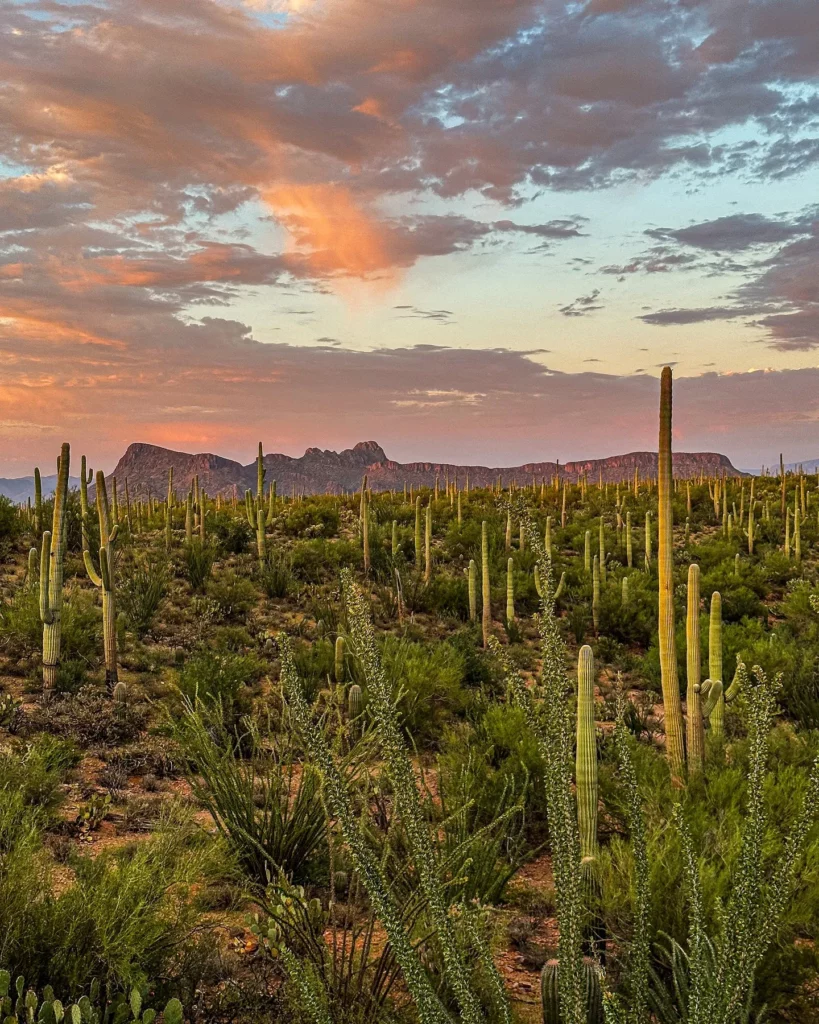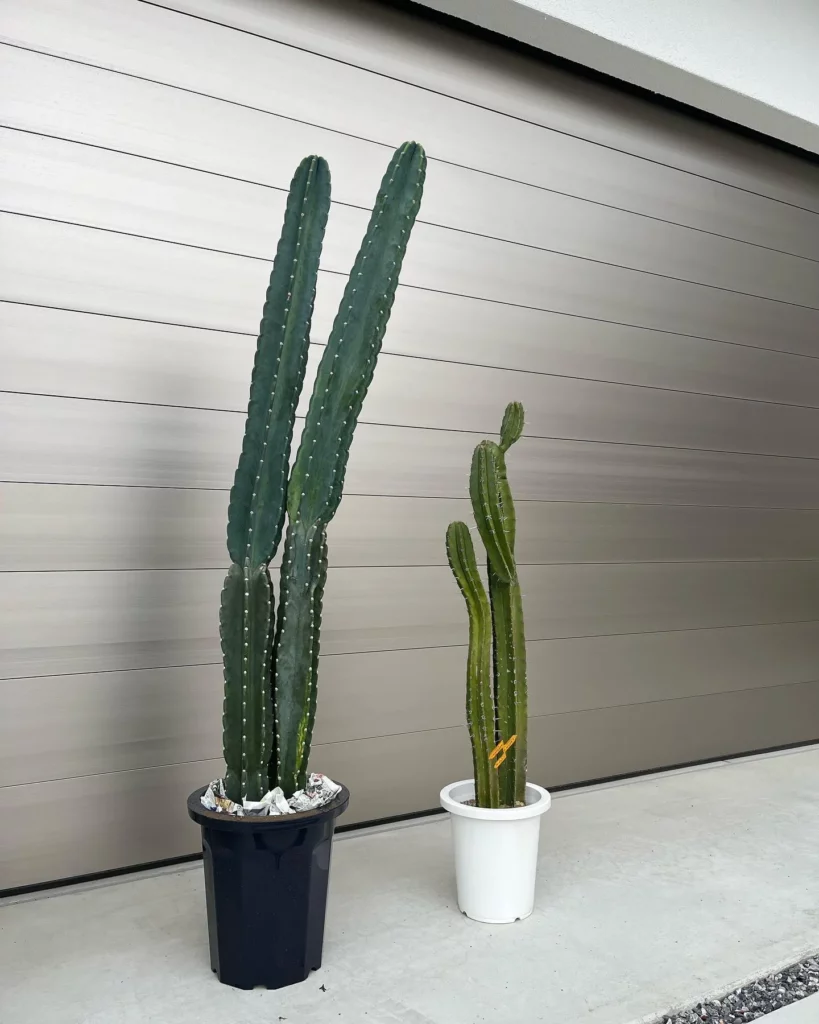Growing and nurturing a Saguaro cactus can be a rewarding experience. These unique plants are native to the Sonoran Desert in Arizona and require specific care practices to thrive. In this guide, I will provide you with essential care tips and practices to help you successfully care for your Saguaro cactus.
Key Takeaways:
- Proper care is crucial for the health and growth of Saguaro cacti.
- Saguaro cacti require well-drained soil, low levels of water, and annual fertilization in the spring.
- Be watchful for pests and diseases, such as scale and mealybugs, and address them promptly.
- Transplanting a Saguaro cactus should be done with caution and requires careful marking of sun exposure.
- Moderation is key when it comes to watering and fertilizing Saguaro cacti.
Characteristics of Saguaro Cactus



When it comes to the Saguaro cactus, its unique characteristics make it stand out in the desert landscape. Let’s explore some of the key features that define this iconic plant.
Appearance
The Saguaro cactus has a distinct barrel-shaped body with a pleated trunk. These pleats allow the cactus to expand and store water during the rainy season, helping it survive in the arid desert environment. The mature Saguaro cacti can reach heights of up to 40 feet and have a lifespan of up to 175 years.
Pleated Trunk
One of the most recognizable traits of the Saguaro cactus is its pleated trunk. These pleats not only give the cactus its unique appearance but also serve a practical purpose. They allow the cactus to expand and contract as it absorbs and stores water, helping it survive during times of drought.
Peripheral Stems
Another defining characteristic of the Saguaro cactus is its peripheral stems, also known as arms. These arms typically start growing when the cactus reaches 50 to 100 years of age. The number of arms a Saguaro has can vary, with some cacti having multiple arms while others may have none at all. The arms provide additional surface area for the cactus to collect sunlight and photosynthesize.
Growing Conditions for Saguaro Cactus



When it comes to nurturing Saguaro cacti, understanding their growing conditions is essential. These majestic plants are native to the Sonoran Desert, which means they thrive in arid environments with specific characteristics. Here are some key factors to consider:
- Sonoran Desert: Saguaro cacti can only grow in areas that do not freeze. They are specifically adapted to the unique desert ecosystem of the Sonoran Desert in Arizona.
- Freeze Tolerance: These cacti cannot survive in regions with freezing temperatures. They need warm, frost-free climates to thrive.
- Elevation: Saguaro cacti can be found at elevations up to 4,000 feet. However, above this elevation, they can only survive on south-facing slopes with fewer freezes.
Saguaro Cactus Care Tips



When it comes to caring for a Saguaro cactus, there are a few key tips to keep in mind. These fascinating plants require specific care practices to thrive in your home garden. Here are some essential care tips to ensure the health and vitality of your Saguaro cactus:
Well-drained Soil:
Saguaro cacti thrive in well-drained soil. It’s important to choose a soil mix specifically designed for cacti and succulents to provide optimal drainage. Avoid overwatering and make sure the soil completely dries out between waterings.
Low Water Levels:
One of the most important aspects of Saguaro cactus care is maintaining low water levels. These desert dwellers are adapted to arid conditions and can store water in their pleated trunks. Water your Saguaro cactus sparingly, especially during the winter months when they are in a dormant state.
Annual Fertilization:
In the springtime, give your Saguaro cactus a boost by fertilizing it with a cactus-specific fertilizer. This will provide the necessary nutrients to support its growth cycle. Follow the instructions on the fertilizer package for the proper application and dosage.
Propagating Saguaro Cactus



Propagating Saguaro cactus can be an interesting and rewarding process. These magnificent cacti naturally propagate by growing under the protection of nurse trees. These trees provide shelter from the intense desert sun and help disperse moisture through evaporation, creating a favorable environment for the growth of Saguaro cactus babies.
When propagating Saguaro cactus, it is important to replicate these natural conditions. One method is to create a sheltered area for the young cacti, using materials such as shade cloth or small awnings. This helps protect them from excessive sunlight and aids in moisture retention.
Moisture Dispersal
Moisture dispersal is another important factor in successful propagation. Mimicking the evaporation process carried out by nurse trees, you can lightly mist the area surrounding the young cacti. This helps create a microclimate that encourages healthy growth.
Saguaro Cactus Babies
Saguaro cactus babies should be left undisturbed until they are well-established and have developed a strong root system. It may take several years for them to reach a size where they can be transplanted to a new location if desired. It is important to note that trying to transplant mature Saguaro cacti can often result in their demise, so it is best to focus on propagating younger specimens.
- Create a sheltered area for young cacti to protect them from excessive sunlight.
- Mist the surrounding area to mimic moisture dispersal by nurse trees.
- Allow Saguaro cactus babies to establish strong root systems before transplanting.
Flowering of Saguaro Cactus


The Saguaro cactus is known for its spectacular flowering display, which occurs in late spring and early summer. The blossoms, measuring about 3 inches across, are creamy white and add a touch of beauty to the arid desert landscape. However, what makes the flowering of Saguaro cactus even more fascinating is the unique pollination process.
Pollination by Nocturnal Creatures
Saguaro cactus flowers open only at night, attracting nocturnal pollinators such as moths and bats. These creatures play a crucial role in the reproductive cycle of the cactus by transferring pollen from one flower to another. As the pollinators feed on the nectar contained within the flowers, they inadvertently collect and distribute the pollen, ensuring the survival and propagation of the species.
The timing of the cactus blossom is synchronized with the activity of these nocturnal creatures. The flowers are at their most fragrant and visually appealing during the night, attracting the pollinators and maximizing the chances of successful pollination.
A Sight to Behold
The flowering of Saguaro cactus is truly a sight to behold. The creamy white blossoms provide a striking contrast against the green, ribbed bodies of the cactus, creating a captivating visual display in the desert landscape. Whether located at the end of the arms or adorning the sides of the cactus, the flowers add a touch of elegance to these majestic plants.
So, the next time you find yourself in the Sonoran Desert during late spring or early summer, keep an eye out for the exquisite flowering of the Saguaro cactus. It’s a natural spectacle that showcases the beauty and resilience of these iconic desert plants.
Pests and Diseases of Saguaro Cactus
When caring for Saguaro cacti, it’s important to be aware of potential pests and diseases that can affect their health. Here are some common issues to watch out for:
Pests:
- Scale: These small insects can infest Saguaro cacti and cause damage by sucking sap from the plant.
- Mealybugs: Mealybugs are another common pest that can attack Saguaro cacti. They are small, soft-bodied insects that feed on the plant’s juices.
Diseases:
- Bacterial Infections: Saguaro cacti can develop bacterial infections, which typically start from the ground up. It is important to promptly remove any rotted areas with clean tools and treat them with sulfur to prevent further infection.
If you notice any signs of pests or diseases on your Saguaro cactus, it is important to take action to prevent further damage. Pests can be controlled manually by removing them with a soft brush or cloth. In severe cases, chemical treatments may be necessary, but it is important to follow the instructions carefully and use products specifically recommended for cacti.
Transplanting Saguaro Cactus
Transplanting a Saguaro cactus can be a challenging task, especially for cacti over three feet tall. These cacti have a shallow root system, making it crucial to handle them with care during the transplanting process. It is important to ensure that the cactus is planted in the same sun exposure to maintain its growth and health.
When transplanting a Saguaro cactus, it is essential to mark the western exposure side of the cactus to ensure it receives the same amount of sunlight as before. The cactus should be placed in well-drained soil to prevent water pooling around the base, which can lead to root rot. Taking these precautions will help the cactus adapt and thrive in its new environment.
In the wild, young Saguaro cacti grow under the protection of parent plants and gradually adapt to the sun as they outgrow their surroundings. When transplanting a mature Saguaro cactus, it is important to replicate this natural progression by planting it in a similar sun exposure. By maintaining the same sun exposure and providing proper care, the transplanted Saguaro cactus has a better chance of thriving and adapting to its new home.
Watchful Care for Saguaro Cactus
When it comes to caring for Saguaro cacti, watchful care is essential. These desert plants are slow to show problems, so it’s important to inspect them regularly for any signs of trouble. Here are some key points to keep in mind:
- Inspect your Saguaro cactus: Take the time to closely examine your cactus for any signs of leaning, sunburn, bacterial infections, or rot. Catching these issues early can help prevent further damage.
- Address problems promptly: If you notice any problems during your inspection, it’s important to take action right away. Leaning cacti may need support, sunburned areas should be shaded, bacterial infections should be treated, and areas of rot should be removed and treated with sulfur to prevent further infection.
- Be patient: Saguaro cacti are slow growers and slow to show problems. It may take months or even years for signs of trouble to become apparent. Keeping a close eye on your cactus and addressing any issues promptly will help ensure its long-term health and vitality.
Importance of Moderation in Saguaro Cactus Care
When it comes to caring for Saguaro cacti, moderation is key. These unique desert plants are adapted to arid conditions and can easily suffer from overwatering. It is crucial to understand their specific care needs to ensure their health and longevity.
Watering plays a vital role in the care of Saguaro cacti. These plants should only be watered during the summer months when the risk of freezing temperatures is low. It is important to avoid excessive watering and allow the soil to dry out completely between irrigation cycles. This mimics their natural environment in the Sonoran Desert where water is scarce.
Fertilization is another aspect of care that should be approached with moderation. Saguaro cacti are resilient and can obtain the necessary nutrients from the surrounding soil. Therefore, additional fertilization is not necessary and can even be harmful if overdone. It is best to refrain from using fertilizers and instead focus on providing well-drained soil and appropriate watering practices.
Key Takeaways:
- Practice moderation in watering, allowing the soil to dry out between irrigation cycles.
- Avoid overwatering, as Saguaro cacti are adapted to arid conditions.
- Refrain from fertilizing, as these cacti can obtain nutrients from the soil.
Conclusion
After exploring the ins and outs of Saguaro cactus care, it is evident that these magnificent plants can be relatively easy to maintain with the right knowledge and practices. By providing proper watering, well-drained soil, and vigilant pest control, you can help your Saguaro cactus thrive in your home garden.
It’s important to remember that Saguaro cacti have specific needs and are best suited to their natural habitat in the Sonoran Desert. Before deciding to grow them, consider the unique characteristics of these cacti and ensure you can provide the necessary conditions for their well-being.
With their slow growth and long lifespan, Saguaro cacti are truly fascinating additions to any landscape. By following the care guide outlined in this article, you can enjoy the beauty and resilience of these iconic desert plants for years to come. So why not give it a try? Create a little piece of the desert in your own backyard and marvel at the wonders of Saguaro cactus care.
FAQ
How long does it take for a Saguaro cactus to produce its first arm or lateral stem?
It can take up to 75 years for a Saguaro cactus to produce its first arm or lateral stem.
What are the characteristics of a Saguaro cactus?
Saguaro cacti have barrel-shaped bodies with pleated trunks that expand to store water during the rainy season. They also have peripheral stems called arms.
Where are Saguaro cacti native to and where can they grow?
Saguaro cacti are native to the Sonoran Desert in Arizona and can only grow in areas that don’t freeze. They can be found at elevations up to 4,000 feet.
What are the growing conditions for Saguaro cactus?
Saguaro cacti require well-drained soil, low levels of water, and elevations below 4,000 feet. They can only survive on south-facing slopes with fewer freezes above this elevation.
How should I care for a Saguaro cactus?
Saguaro cacti require well-drained soil, low levels of water, and annual fertilization with cactus food in the spring. It is important to be watchful for pests and diseases.
How do Saguaro cacti propagate?
Saguaro cacti propagate naturally by growing under the protection of nurse trees. These trees provide shelter from the sun and help disperse moisture through evaporation.
When do Saguaro cacti flower and how are they pollinated?
Saguaro cacti typically start producing flowers around 35 years of age. The flowers bloom in May to June, are creamy white, and open at night. They are pollinated by moths, bats, and other nocturnal creatures.
What pests and diseases can affect Saguaro cacti?
Saguaro cacti can be susceptible to pests such as scale and mealybugs. They can also develop bacterial infections, which typically start from the ground up.
Can I transplant a mature Saguaro cactus?
Transplanting a mature Saguaro cactus over three feet tall is a difficult task and often not recommended as they often do not survive the process.
How should I care for and inspect my Saguaro cactus?
It’s important to regularly inspect your Saguaro cactus for any signs of leaning, sunburn, bacterial infections, or rot. Dead or fallen Saguaro cacti can still survive on stored reserves for up to 10 years.
What is the importance of moderation in Saguaro cactus care?
Moderation is key when caring for Saguaro cacti. Overwatering can lead to their death, as they are adapted to arid conditions. Fertilization is also not necessary as they can obtain the nutrients they need from the soil.




